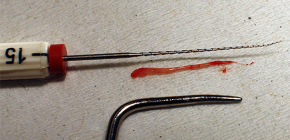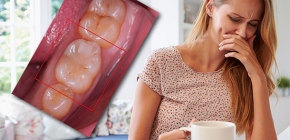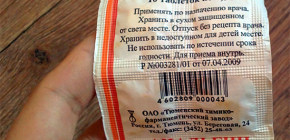Dental treatment

Removing a nerve from a tooth is a very important procedure, which, unfortunately, does not always go smoothly for the patient. Improper preparation for work with the “nerve” and medical errors can lead to dire consequences, starting from terrible pain during and after removing the pulp, and ending with bleeding from the tooth and a broken and forgotten instrument in the canal. Why is it generally necessary to remove the nerve from the tooth, how this happens and what problems may await you along the way - we will talk more about this in more detail ...

Toothache for many pregnant women is a real nightmare. At least because future mothers are no less afraid of going to the dentist than drinking pills. As a result, slight signs of tooth decay and slight soreness are completely ignored at first, then the pain intensifies, often developing into a serious problem over time. And often by the time of childbirth, when it is already really undesirable to go to the dentist, a pregnant woman feels a toothache of such strength that childbirth no longer seems so terrible to her. How to behave properly if a tooth starts to hurt during pregnancy, and how can it be reassured without harming the developing fetus? In these matters we will continue to try to understand in more detail.

People who had to experience the symptoms of purulent pulpitis on themselves, usually do not forget the experienced feelings already never. And this is due to the fact that due to the inflammatory reaction inside the tooth and compression of the neurovascular bundle by purulent exudate, severe pain occurs that often radiates to various parts of the face, upper or lower jaw, in the head. It is the lack of a clear localization of pain that creates a serious problem in determining the pulpitis tooth at the dentist at the stage of diagnosis. Hence the mass of ridiculous cases when healthy teeth are drilled or removed by mistake. Let us talk about all these points, as well as what the patient should and should not do in such a situation.

Analgin was also used for toothache by our parents and grandparents. And today, this tool remains one of the most popular painkillers in Russia, although with the advent of more modern and safer substitutes, its former "glory" pretty quickly fades. Next, we will try to figure out how effective and appropriate the use of Analgin to relieve toothache, and why it is increasingly abandoned in favor of other drugs ...

When a tooth hurts badly, and there is no possibility or desire to get an appointment with the dentist, then a variety of means are used: from trying to pick your own tooth with a needle, to all kinds of prayers and conspiracies. If a person is sure that a conspiracy from a toothache will help him - well, perhaps it will be so. Oddly enough, but in certain cases it works: pain decreases or even completely disappears. However, it is important to understand here that even if the pain is gone, the disease itself will not disappear, and moreover, if untreated, it can become chronic with serious complications. For the sake of curiosity, let's try to figure out which conspiracies from toothache are most often practiced in alternative medicine and how their healing power is justified ...

Unfortunately, we can face toothache at any time and at any age.Naturally, no dentist will prohibit the use of home methods to get rid of toothache, if they do not contradict common sense and do not have a harmful effect on the body. However, as practice shows, many people are completely unaware of what to do to properly relieve toothache, sometimes they start dangerous self-activity and risk their health. Well, it's time to get acquainted with folk and professional methods of help in such situations, as well as learn more about the various mechanisms of toothache.

Chronic gangrenous pulpitis is associated with the occurrence of irreversible pulp necrosis inside the root canals of the tooth, and it can be cured only by removing the decomposing tissue of the neurovascular bundle. The transformation of “living” tissue into pus is a very unpleasant tendency, since there is a great risk that all this content will go towards the apex of the root and exit into the tissues surrounding the tooth, where it will form either a fistulous passage through which the pus will pour into the oral cavity , or "flux" on the gum. Therefore, gangrenous pulpitis is considered to be a borderline form, when only one step remains before periodontitis and diffuse purulent inflammation ...

Generally speaking, folk remedies for toothache are much less effective than modern pharmaceuticals. However, in many cases, those who suffer from pain in the teeth prefer folk recipes rather than various pills. And there is nothing surprising in this: it is generally accepted that folk remedies are safer, and therefore they can be used without harm to health. But are folk remedies always safe? And which of them can really effectively calm a toothache, and which ones will not give a special effect? Let's figure it out ...

It often happens that, it would seem, the tooth has already been cured, a seal has been placed, but suddenly it starts to hurt. Especially often pain occurs after treatment and filling of channels. Is this the norm, and if so, how long will it take to endure such pain? Why does this pain occur and can it be dangerous by any complications? We will consider the answers to these and some other interesting questions further ...

It would seem that a tooth closed with a crown should not hurt, since as a result of treatment it appears to be walled up in a kind of “sarcophagus” that reliably protects from external influences. However, life dictates its own rules, and sometimes there are cases of pain under the crown - immediately or after some time after its installation. A certain percentage of pain passes quickly and without harm to a person, but there are situations when a tooth under a crown or a gum adjacent to it needs serious help to avoid complications such as gum swelling, fistula with pus, abscesses and osteomyelitis, often leading to tooth extraction . What you need to know about the pain under the crown, in which cases you can relieve pain at home (and how to do it), and in which cases it is better to consult a doctor right away, as well as what you can expect in a dental clinic - all this we’ll talk later ...
